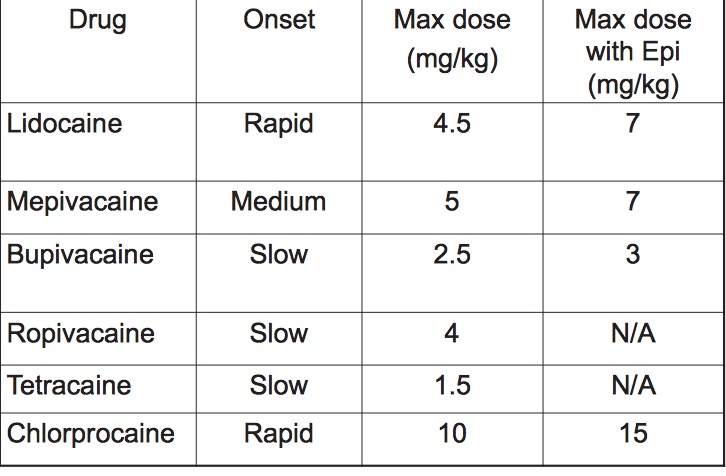CASE: 50 y/o, 70 kg woman is having a bunionectomy under ankle block to be performed by the surgeon. He plans to use 0.5 % bupivacaine with epinephrine 1:200,000.
What is the concentration of bupivacaine being used in mg/ml?
Calculate the mg/mL concentration quickly from the percentage by moving the decimal point 1 place to the right. In this example, 0.5% bupivacaine = 5 mg/ml buipivacaine.
Why is epinephrine added to local anesthetic solutions?
Epinephrine induced vasoconstriction reduces systemic side effects of lidocaine and allows a greater dose of lidocaine to be given.
Is the above solution appropriate for use in a penile block? Explain.
Yes. "Supplementing a local anesthetic with epinephrine in penis operations has many advantages, including high patient satisfaction, relatively painless infiltration, low complication rates, improved view of the operating field, and an extended effect of anesthetics with a prolonged reduction in pain. Because of the anatomy of the organ, there is no risk of necrosis related to using a subcutaneous penile ring block. Thus the view that epinephrine should not be used in penis procedures is obsolete." – See Schnabl et al. 2014
What is the maximum dose of bupivacaine for this patient in mg and ml?
Max dose of bupivacaine with epinephrine = 3 mg/kg x 70 = 210 mg.
Concentration of 0.5% bupivacaine = 5 mg/ml; 210 mg / (5 mg/ml)= 42 ml
Is bupivacaine an ester or amide?
Amide. You can tell because it has 2 "i"s in its name.
CASE (cont.) 3 Minutes after injecting 20 ml of local anesthetic, the surgeon tests the operative site and patient flinches.
What determines the speed of onset of local anesthetics?
- Speed of onset is related to pKa (i.e. degree of ionization)
What determines potency and duration?
- Potency is related to lipid solubility.
- Duration of action is related to protein binding.
Describe the onset and maximum doses of common local anesthetics.

CASE (cont.) The surgeon decides to use some 2% lidocaine. Shortly afterward, patient reports feeling ill.
What are the signs and symptoms of local anesthetic toxicity?
CNS: Lightheadedness, tinnitus, tongue numbness (CNS Excitation) → CNS depression, seizure → coma
Cardiovascular (Requires much greater doses): Dose dependent blockage of Na Channels → disruption of cardiac conduction system → bradycardia, ventricular dysrhythmias, decreased contractility, cardiovascular collapse/circulatory arrest.
How is lidocaine different from bupivacaine with respect to toxicity?
Bupivacaine is more cardiotoxic than lidocaine.
How common is an allergic reaction to local anesthetics?
Extremely rare.
Explain why local anesthetics are ineffective at the site of infection.
Lidocaine requires an alkaline environment to function. This is because the basic environment creates the non-acidic form lidocaine must take in order to cross the neuronal membrane. Infections create an acidic environment, which neutralizes local anesthetics.